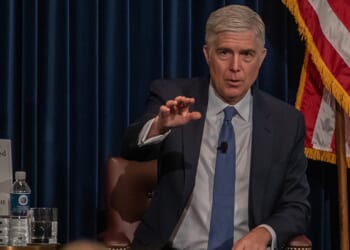Overwhelmed by crises in Europe and the Middle East, Washington may be tempted to see the unfolding crisis as a secondary concern. That would be a profound mistake.
Open conflict has erupted between India and Pakistan, once again raising the possibility of nuclear confrontation. Indian missile strikes into Pakistan and Pakistani-controlled Kashmir have resulted in eight deaths, according to Pakistani officials. At the same time, Islamabad claims to have shot down two (or more) Indian fighter jets over its territory. Shelling and heavy gunfire have also broken out along the Line of Control (LOC), the heavily militarized de facto border that divides Indian- and Pakistani-controlled parts of Kashmir.
Pakistan’s defense minister has said a “forceful response is being given.” As fighting intensifies, the United States now faces a narrow but urgent opportunity that requires modest, focused diplomatic engagement to prevent further escalation, reinforce U.S. credibility, and avoid much higher costs in areas beyond South Asia later.
The outbreak follows weeks of rising tensions that began after a deadly terrorist attack in the town of Pahalgam in Kashmir, which India attributed to militants linked to Pakistani intelligence. New Delhi initially responded by “test-firing” several anti-ship missiles and announcing plans to suspend the Indus Waters Treaty—a move that triggered panic in parts of Pakistan where water is scarce. Pakistan then escalated its rhetoric with unusual directness, stating that any attempt to cease water flows would constitute an “act of war.” Islamabad followed up with threats to launch ballistic missiles at India and by suspending the 1972 Simla Agreement that established the LOC and committed both sides to resolve the Kashmir dispute peacefully.
With cross-border strikes now underway, the latest South Asia crisis has entered a dangerous new phase. The need for urgent, calibrated diplomatic engagement is now more critical than ever.
However, the risks of further escalation are serious and accelerating. Communications and signaling strategies that might have eased tensions in the past are far more fragile today, as the dynamics between India and Pakistan have become increasingly compressed and brittle. Nationalist politics in both India and Pakistan leave little room to promote restraint or diplomatic compromise.
Military doctrines on both sides have evolved toward prioritizing rapid military responses, increasing the chances of misinterpretation and overreaction. India’s missile launches signal not just a show of strength but a calculated escalation of strategic messaging. Meanwhile, Pakistan’s open nuclear threats potentially lower the rhetorical threshold for nuclear use in a way rarely seen in previous crises. In this environment, opportunities for de-escalation are fewer, narrower, and more difficult to seize.
This is no longer a crisis waiting to erupt. It is a crisis already unfolding, revealing just how thin South Asia’s veneer has become.
The United States has confronted this challenge before — and has succeeded. During the 2019 Pulwama-Balakot crisis, after a suicide bombing in Kashmir provoked Indian airstrikes within Pakistan, Washington played a decisive role in halting escalation. Then-Secretary of State Mike Pompeo engaged directly with Indian and Pakistani leadership while American diplomats leveraged informal networks and engaged regional partners to deliver private messages urging restraint. Public statements called for de-escalation without apportioning blame, preserving vital political space for both sides. The episode demonstrated that early, calibrated U.S. engagement on multiple levels could empower both India and Pakistan to find off-ramps without appearing to capitulate.
While diplomatic and informal ties may not exist in the same way they did in 2019, the underlying principle remains valid. Neither India nor Pakistan seeks a full-scale war, and certainly not a nuclear exchange. Both governments, despite their aggressive rhetoric, are looking for ways to secure domestic political advantages from crises without triggering uncontrollable escalation. The shrinking space for maneuver makes timely outside engagement all the more consequential.
The goal should not be to dictate outcomes but to de-risk by buying time, calming nationalist fervor, and preserving political options for de-escalation.
Strategic incentives for U.S. action are compelling. Stabilizing South Asia with limited diplomatic effort would demonstrate that American leadership remains capable of quickly pivoting and managing unpredictable crises even while juggling multiple other issues. America’s Indo-Pacific allies and partners, including Taiwan, will see this as bolstering deterrence against China. It would reassure these allies’ concerns about America’s staying power and credibility while also strengthening U.S. leadership in global nuclear risk reduction efforts at a time when these tenets are under increasing strain.
Indeed, Washington has taken initial steps to urge restraint, with senior officials reaching out to both Indian and Pakistani counterparts to encourage a “responsible solution” to the crisis. This engagement is a welcome start. However, it must be sustained and deepened through more active, calibrated efforts to meaningfully reduce the risk of escalation and protect broader U.S. strategic interests.
These efforts must be undertaken quickly and at senior levels. While they need not be expansive or high-profile, they should be consistent, visible, and sustained. A smart crisis management strategy would include early public calls for restraint, urging the immediate cessation of all military strikes and live fire along the LOC, as well as military signaling involving missile platforms; private senior-level communications encouraging reactivation of crisis communication channels; quiet coordination with regional stakeholders who retain access to both governments; and military-to-military engagement reinforcing the importance of avoiding further military actions.
Following a policy of measured diplomatic engagement would align with the administration’s stated priorities. President Trump has repeatedly emphasized the catastrophic consequences of nuclear war, describing nuclear weapons as the greatest threat to humanity. In recent weeks, he has renewed his emphasis on the dangers of nuclear conflict and underscored the importance of avoiding global nuclear confrontation. Early diplomatic intervention to manage the India-Pakistan crisis aligns directly with these goals by preventing nuclear instability at a low cost while preserving strategic bandwidth for great power competition.
Beyond immediate regional consequences, a worsening India-Pakistan crisis would directly harm broader U.S. strategic interests. Further escalation would force India to shift attention and resources away from its emerging role as a counterweight to China, undercutting Washington’s Indo-Pacific strategy. It would also risk deepening U.S.-China tensions. Beijing, as Pakistan’s principal strategic partner, would likely become more involved if military conflict erupted.
The Trump administration has made early moves to strengthen its partnership with India. In the aftermath of the terrorist attack, public statements by top U.S. officials expressed full support and solidarity with India without substantive outreach to Pakistan. However, Washington has a strategic incentive to maintain a more balanced posture. Appearing to side with New Delhi would place Washington and Beijing on opposing sides of any open-ended India-Pakistan conflict, deepening bilateral tensions and hardening competition before the United States has fully bolstered its Indo-Pacific architecture to counter China. Moreover, it would further undercut prospects for strategic cooperation with China in areas of mutual interest that the United States has indicated it still seeks, including risk reduction, arms control, and crisis management frameworks.
However, the United States could proactively turn the crisis into an opportunity for U.S.-China cooperation if it moves quickly. China has publicly called for both sides to “exercise restraint” and return to dialogue and consultation. The United States should openly support this call for dialogue and offer to work together diplomatically to bring the crisis to a peaceful conclusion.
Policymakers in Washington, understandably overwhelmed by crises in Europe and the Middle East, may be tempted to treat the region and the unfolding crisis as a secondary concern. That would be a profound mistake. History shows that early, smart diplomatic engagement can prevent catastrophe.
The United States need not intervene militarily but rather commit to targeted, measured, and cooperative diplomacy while time still permits. Action now will deliver strategic and political gains at minimal cost. A bloodier conflict between India and Pakistan threatens more than just South Asia—it has real consequences for broader U.S. strategic interests. How Washington navigates this moment will either reinforce those interests or undermine them by unnecessarily intensifying competition with China and complicating its Indo-Pacific priorities.
About the Authors: Shawn Rostker
Shawn Rostker is a Research Analyst with the Center for Arms Control and Non-Proliferation. His research investigates issues of nuclear strategy, arms control and emerging technologies, with a regional focus on East Asia. Prior to joining the Center, Rostker worked on technology policy and competition at the Center for Strategic and International Studies, as well as nuclear deterrence and the North Korean weapons program during his time at the Center for Political-Military Analysis. He holds a Bachelor’s in International Relations from the University of California, San Diego where he graduated summa cum laude, and a Master’s in Security Studies from Georgetown University.
Image: BoeingMan777 / Shutterstock.com.















